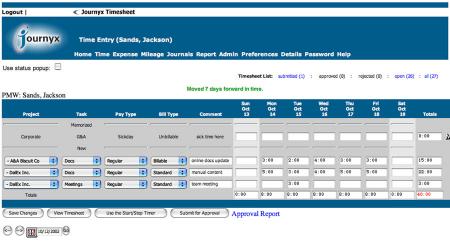Python Success Stories
Introduction
Journyx Timesheet (tm) is a commercial application that provides time, expense, and project tracking. In 1996, Curt Finch, Journyx CEO and founder, was working in the staffing industry when he saw an opportunity to use the web to accurately collect and store employee timesheet information.

Journyx Time Entry Screen Zoom in
The first version of Timesheet focused on collecting accurate cost information, with an eye towards applying that data in the formulation of new project cost projections. Since then, Timesheet has expanded considerably to facilitate tracking of time, mileage, and expenses, not just for project management but also for billing and payroll purposes. Optional modules are available for paper-less expense reporting, advanced user role management, automated billing and payroll, and to facilitate system access for disconnected traveling users.
Today, Timesheet is platform-independent, flexible enough to be reconfigured by customers to fit unique organizational needs, and scales to tens of thousands of users for the large enterprise.
Python From the Start
Journyx Timesheet has been using Python from the beginning. Curt Finch chose Python initially on the recommendation of a friend, Steve Madere, who had founded Dejanews.com (now a part of Google). Describing the rationale for his choice, Curt said "I looked at Java and C and came to the conclusion that 1 line of Python is 10 lines of Java or 100 lines of C. Developers write code at basically a constant rate so I chose Python which was (and is) the highest level language I've ever seen that is also flexible enough to be generally useful."
Architecture
From the beginning, Timesheet was designed and implemented as a web application. It uses a three-tiered web application architecture with separate layers for web presentation, business logic, and data storage. As time has progressed, the application's functionality has advanced considerably, and Curt's decision to use Python for an implementation language has proven to be good choice.
Python is currently used for all application logic in the Timesheet application. This includes all code between the initial Apache dispatch, where mod_python is employed to expedite interpreter instantiation, though the application logic, and down to the point of call out to the database transport layer.
Timesheet uses not only the Python standard library but also several independently developed open source Python subsystems, such as PyXML and ActZero's SOAP support. PyXML is used to implement certain business rules and to develop jxAPI, which is a SOAP-based API into the application logic. Work is in progress to extend this API to define Web Services Description Language templates for the jxAPI functions. The application currently builds and ships with Python 2.1.1.
Timesheet also incorporates several non-Python technologies. The Unix and Linux distributions are packaged with the Apache HTTP server and PostgreSQL database. The Timesheet distribution for Windows ships with an optional Microsoft Desktop Engine (MSDE) database and integrates with Microsoft IIS. Timesheet can be configured to use a variety of third-party databases.
Results
The Timesheet project has succeeded spectacularly, generating millions in revenue and allowing Journyx to grow every year, even under the current economic conditions.
Journyx, like many of our customers, uses Timesheet internally as a mission critical part of the company infrastructure. It is used extensively for project tracking, billing, and payroll.
To date, approximately 11 person-years have gone into the Journyx Timesheet product, resulting in over one hundred fifty thousand lines of Python code.
In developing Journyx, the two greatest benefits of Python were the speed with which features could be written and deployed, and its true write-once-run-anywhere cross-platform capabilities.
Journyx developers have found that the simplicity and clarity of Python combine with its object-oriented properties to make it a very powerful and productive language. Python's rich standard library, which includes modules for things like string manipulation and HTML generation, further supports programmers in meeting aggressive development schedules.
Because of these properties of the language, Python has enabled Journyx to add features more quickly than our competitors. We've been able to implement SOAP/XML and WSDL support and extended other aspects of the application's functionality well ahead of competitive products. One of the key enablers of this efficiency in maintenance and improvement is the inherent clarity and readability of the Python language. Other important factors are the vibrant and responsive Python development community, and the high degree of backwards compatibility and stability we have seen as the language design evolves over time.
Python's cross-platform standard library and platform-independent byte code file format allow the deployment of Python modules to any platform, regardless of which platform the module was prepared on. This helped not only in avoiding per-platform development overhead but also facilitates customer support for the Timesheet software product. For example, a patch module built on a Redhat 6.2 system can be sent to a customer for installation on Windows XP or any other operation system without the need for cross-compilation or translation of any kind.
Conclusion
Python made it possible for Journyx to produce a flexible, feature-rich product for multiple platforms in less time than would have been possible using another language. Python has been an important competitive advantage for us, and even as our Python code base grows in complexity and maturity, the natural advantages of Python enable us to provide a high quality mission critical application at a competitively low cost.
About the Authors
Curt Finch, Journyx founder and CEO, started the company in 1996 after a successful career in the consulting industry participating in and managing engagements with Fortune 100 companies such as Tivoli, IBM, and Prudential Securities.
John Maddalozzo, Journyx V.P. of Engineering, joined Journyx in 1999 after a twelve year career in Unix kernel development at IBM's AIX Engineering group.
